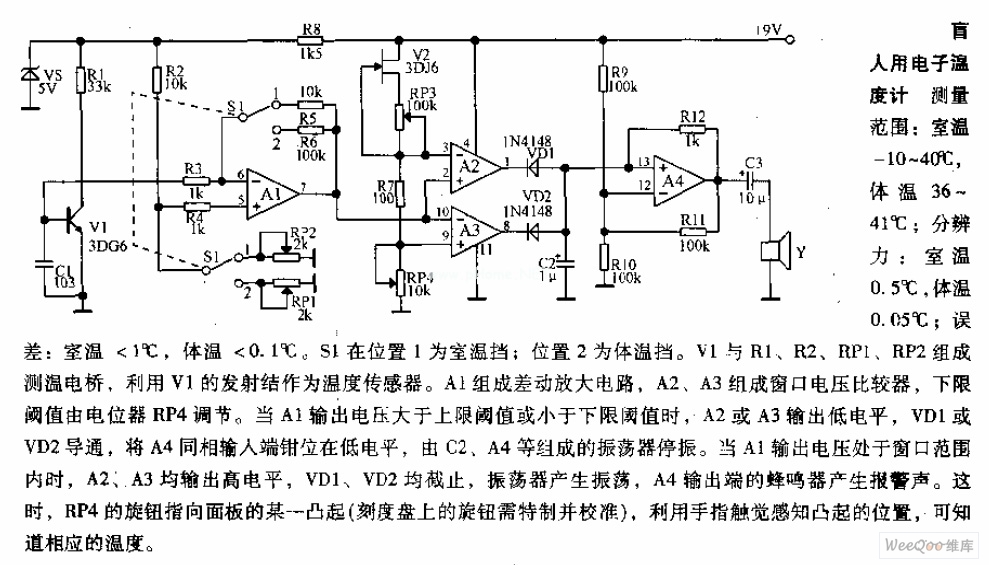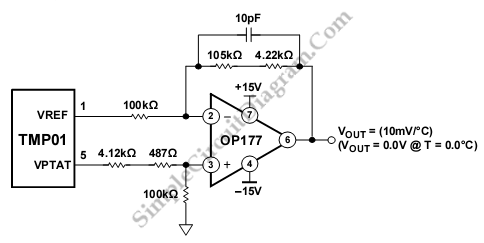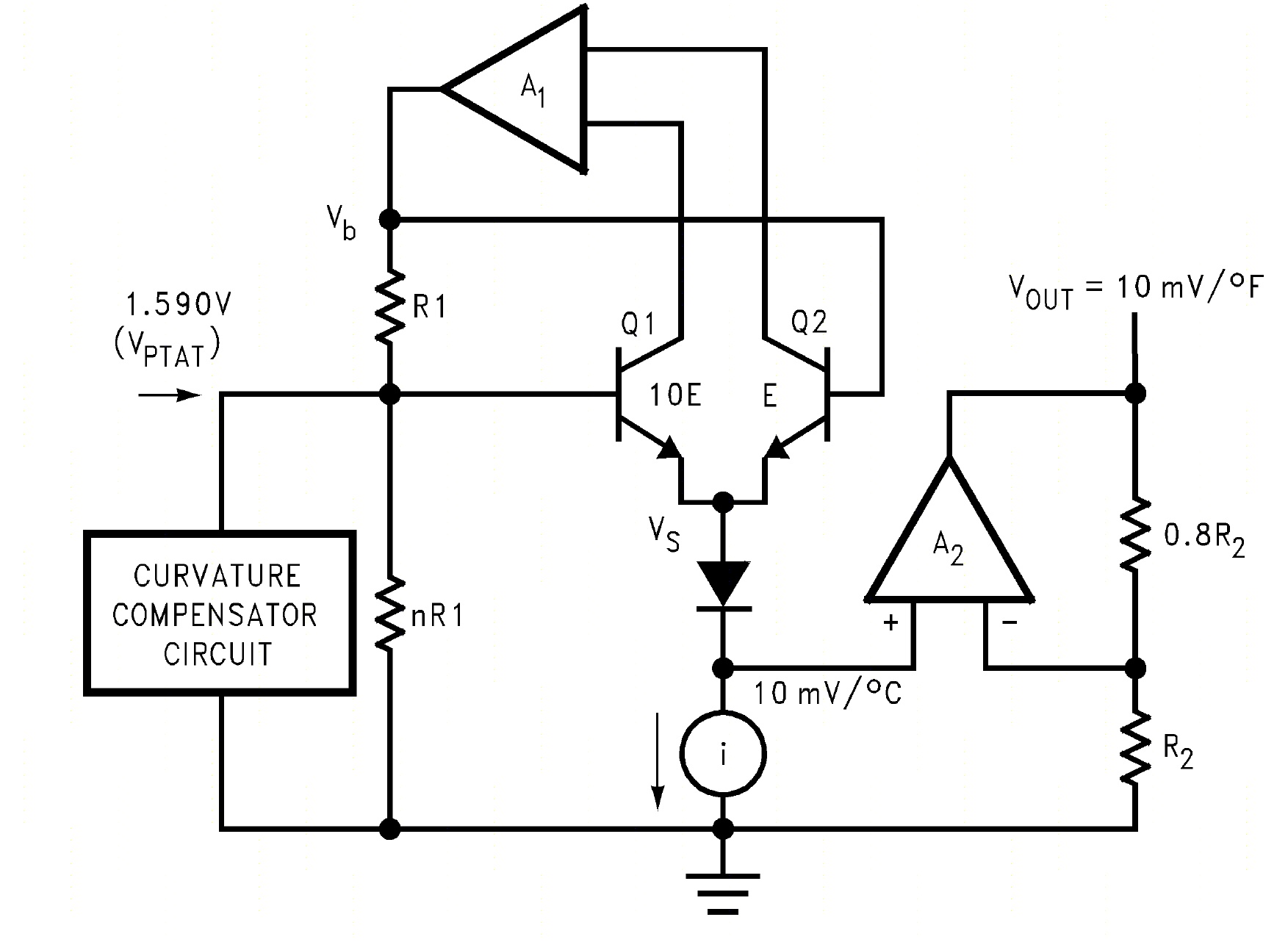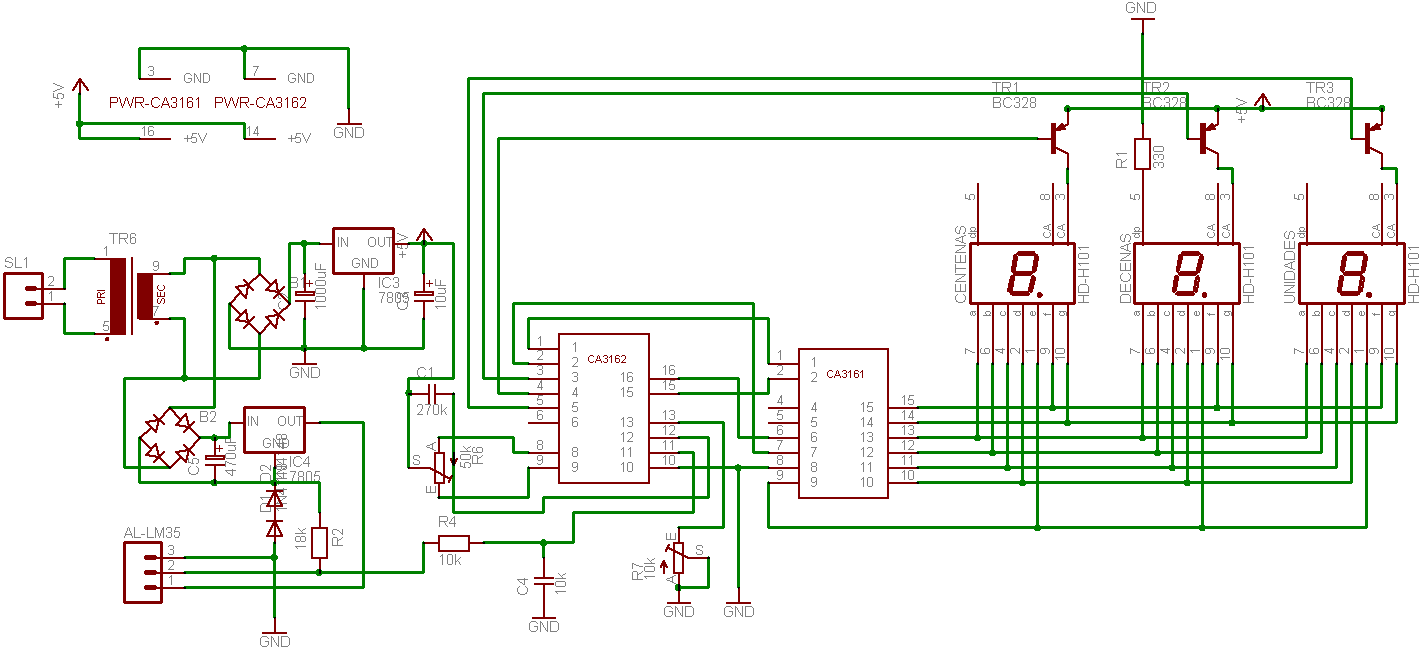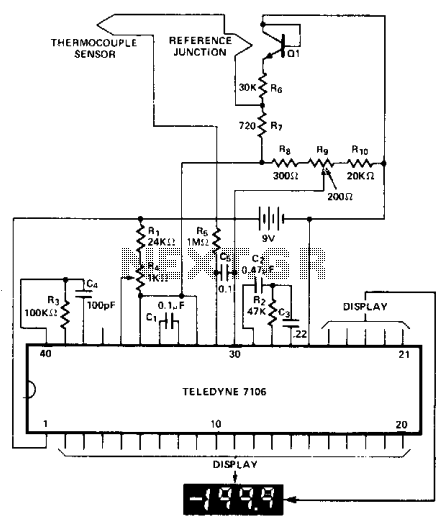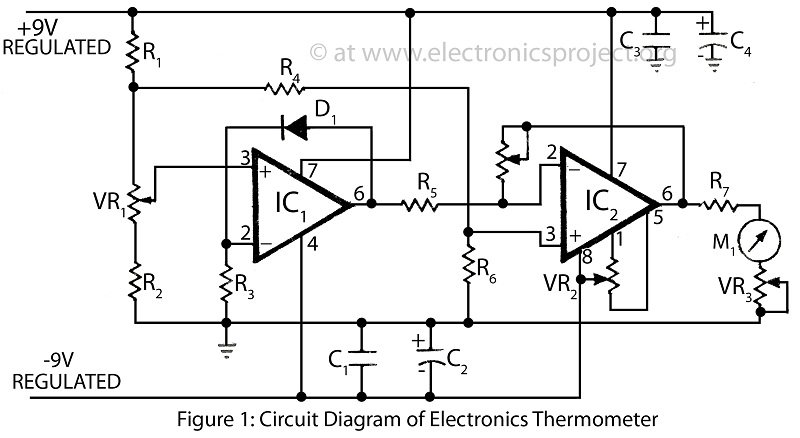
Celsius Thermometer
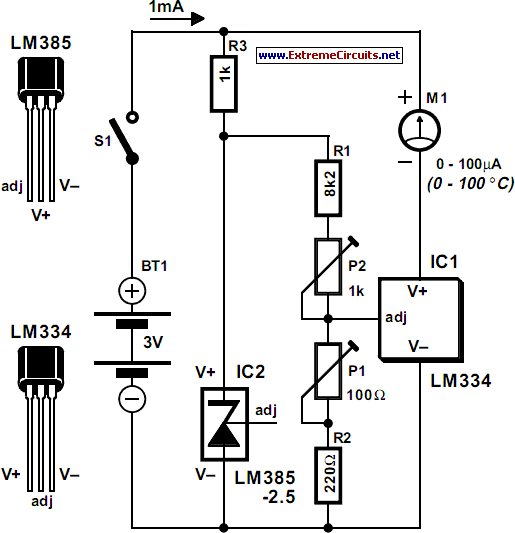
The circuit for the Celsius thermometer depicted in the diagram is based on the well-known LM334 type from National Semiconductor. This integrated circuit (IC) functions as a sensor that outputs a current directly proportional to the temperature in Kelvin (K). However, this measurement is not practical for most applications. Therefore, in the circuit, the sensor is configured to output 1 µA per Kelvin using potentiometer P1, while potentiometer P2 is used to eliminate the offset of 273 K. This adjustment allows the output voltage of the sensor to be directly proportional to the temperature in degrees Celsius (°C), making the circuit suitable for a wide range of applications (since 1 K = 1 °C). The circuit also includes IC2, which is configured as a 2.5 V reference voltage source. The current setting of the sensor is determined by the resistance between the adjust pin and ground. If the ground is made virtual by raising the potential at the adjust pin, the zero point can be shifted as needed. Calibration is best performed using a reliable domestic thermometer as a reference. The process begins by short-circuiting IC2 and adjusting P1 until the reading on meter M1 shows a current value numerically equal to the ambient temperature plus 273. For instance, if the room temperature is 25 °C, P1 should be adjusted until the meter reads 298 µA. After this, the short-circuit on IC2 should be removed, and P2 should be adjusted until the meter reads a current equal to the room temperature, which would be 25 µA. The circuit operates with a current draw not exceeding 1 mA, allowing the use of two AA batteries (AM3, MN1500, LR6, SP/HP7) as a power source, which can provide a lifespan of several years.
The LM334 integrated circuit serves as a versatile temperature sensor, utilizing a current output that varies linearly with temperature changes. The configuration of the sensor for 1 µA per Kelvin is achieved through precise adjustments with potentiometers, ensuring that the output aligns with practical temperature measurements in degrees Celsius. The use of a 2.5 V reference voltage from IC2 stabilizes the circuit, providing a reliable baseline for the current readings.
The calibration procedure outlined is critical for achieving accurate temperature readings. By initially short-circuiting IC2, the adjustment of P1 allows for a direct correlation between the sensor output and the ambient temperature, compensating for the inherent offset of the LM334. This step is essential for establishing a reliable zero point in the measurement system.
Once the initial calibration is complete, the removal of the short-circuit on IC2 and the subsequent adjustment of P2 fine-tunes the output to reflect the actual room temperature. This two-step calibration ensures that the system is not only accurate but also user-friendly, as it can be easily adjusted against a standard thermometer.
The low current draw of the circuit enhances its practicality in battery-powered applications, as it allows for extended operational life with standard AA batteries. This feature makes the Celsius thermometer circuit ideal for portable or remote temperature monitoring applications, where long-term reliability is a key requirement. Overall, this circuit design exemplifies an efficient approach to temperature measurement, combining simplicity with accuracy and longevity.The circuit of the Celsius thermometer in the diagram is based on the well-known Type LM334 from National Semiconductor. This IC is a sensor that provides a current which is directly proportional to the temperature in kelvin (K).
Unfortunately, this is a quantity that is not suitable for use in most practical applications. In the circuit, therefor e, the sensor is set to 1 µA K 1 with P1 and the offset of 273 K removed with P2. This renders the output voltage of the sensor directly proportional to the temperature in degrees Celsius ( ° C) and this makes the circuit suitable for a great many applications (since 1K=1 ° C). Circuit IC2 is arranged as a 2. 5 V reference voltage source. The current setting of the sensor is determined by the resistance between the adj(ust) pin and earth.
If the earth is made virtual by raising the potential at the adj pin, the zero point can be shifted as desired. Calibration is best done by using a good domestic thermometer as reference. Start by short-circuiting IC2 and adjusting P1 until the reading of meter M1 shows a current value numerically equal to the ambient temperature plus 273.
If, say, the room temperature is 25 °C, adjust P1 until the meter reads 298 µA. Then, remove the short-circuit from IC2 and adjust P2 until the meter reads a current whose numerical value is equal to the room temperature, that is, 25 µA. The circuit draws a current not exceeding 1mA, so using two AA size (AM3, MN1500, LR6, SP/HP7) batteries as power source will give a life of a couple of years.
🔗 External reference
The LM334 integrated circuit serves as a versatile temperature sensor, utilizing a current output that varies linearly with temperature changes. The configuration of the sensor for 1 µA per Kelvin is achieved through precise adjustments with potentiometers, ensuring that the output aligns with practical temperature measurements in degrees Celsius. The use of a 2.5 V reference voltage from IC2 stabilizes the circuit, providing a reliable baseline for the current readings.
The calibration procedure outlined is critical for achieving accurate temperature readings. By initially short-circuiting IC2, the adjustment of P1 allows for a direct correlation between the sensor output and the ambient temperature, compensating for the inherent offset of the LM334. This step is essential for establishing a reliable zero point in the measurement system.
Once the initial calibration is complete, the removal of the short-circuit on IC2 and the subsequent adjustment of P2 fine-tunes the output to reflect the actual room temperature. This two-step calibration ensures that the system is not only accurate but also user-friendly, as it can be easily adjusted against a standard thermometer.
The low current draw of the circuit enhances its practicality in battery-powered applications, as it allows for extended operational life with standard AA batteries. This feature makes the Celsius thermometer circuit ideal for portable or remote temperature monitoring applications, where long-term reliability is a key requirement. Overall, this circuit design exemplifies an efficient approach to temperature measurement, combining simplicity with accuracy and longevity.The circuit of the Celsius thermometer in the diagram is based on the well-known Type LM334 from National Semiconductor. This IC is a sensor that provides a current which is directly proportional to the temperature in kelvin (K).
Unfortunately, this is a quantity that is not suitable for use in most practical applications. In the circuit, therefor e, the sensor is set to 1 µA K 1 with P1 and the offset of 273 K removed with P2. This renders the output voltage of the sensor directly proportional to the temperature in degrees Celsius ( ° C) and this makes the circuit suitable for a great many applications (since 1K=1 ° C). Circuit IC2 is arranged as a 2. 5 V reference voltage source. The current setting of the sensor is determined by the resistance between the adj(ust) pin and earth.
If the earth is made virtual by raising the potential at the adj pin, the zero point can be shifted as desired. Calibration is best done by using a good domestic thermometer as reference. Start by short-circuiting IC2 and adjusting P1 until the reading of meter M1 shows a current value numerically equal to the ambient temperature plus 273.
If, say, the room temperature is 25 °C, adjust P1 until the meter reads 298 µA. Then, remove the short-circuit from IC2 and adjust P2 until the meter reads a current whose numerical value is equal to the room temperature, that is, 25 µA. The circuit draws a current not exceeding 1mA, so using two AA size (AM3, MN1500, LR6, SP/HP7) batteries as power source will give a life of a couple of years.
🔗 External reference
